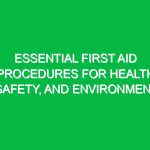Introduction
Hello team, and welcome to today’s Toolbox Talk. Today, we’re going to discuss a critical concept that underpins our Health, Safety, and Environment (HSE) efforts: “It Was a Matter of Time.” This phrase encapsulates the idea that, in the workplace, safety incidents and challenges are often predictable if we do not take proactive measures. Our goal today is to understand this concept fully, recognize its implications, and implement effective strategies to create a safer work environment.
Understanding “It Was a Matter of Time” in HSE
The phrase “It Was a Matter of Time” serves as a reminder that every workplace hazard has the potential to lead to an incident if left unaddressed. This expression speaks to the inevitability of accidents when proactive Safety Measures are not implemented. For example, if a team repeatedly ignores the need for proper Personal Protective Equipment (PPE), it is only a matter of time before someone gets injured.
In HSE, understanding this concept means recognizing that every unsafe condition or behavior is a ticking clock. The sooner we address these issues, the less likely we are to face accidents. By engaging in this Toolbox Talk, we are acknowledging that we have the power to change the narrative from “It Was a Matter of Time” to “It Was a Matter of Prevention.”
The Importance of Proactive Safety Measures
Taking proactive Safety measures is essential for several reasons:
- Preventing Accidents: By identifying and mitigating risks before they escalate, we can prevent accidents and their consequences.
- Legal Compliance: Adhering to Safety Regulations not only protects our employees but also safeguards the company against legal repercussions.
- Enhancing Productivity: A safe work environment increases employee morale and productivity, as workers feel secure in their surroundings.
Real-Life Examples of “It Was a Matter of Time”
To illustrate the concept, let’s consider a couple of real-life scenarios:
- Scenario 1: In a construction site, workers ignored a frayed electrical cord. Despite several warnings, they continued to use it. Eventually, this led to an electrical shock incident. This situation was a classic example of “It Was a Matter of Time” because the hazard was evident and neglected.
- Scenario 2: A factory worker noticed that a safety guard on a machine was missing. Despite raising the concern, no action was taken. A few weeks later, another worker got caught in the machinery. This incident could have been prevented had the issue been addressed timely.
Identifying Potential Hazards
To shift our mindset from “It Was a Matter of Time” to proactive prevention, we first need to identify potential Hazards in our work environment:
- Physical Hazards: These include slips, trips, falls, and machinery-related injuries.
- Chemical Hazards: Exposure to harmful chemicals can lead to serious health issues.
- Ergonomic Hazards: Poor workstation setup can lead to musculoskeletal disorders.
- Psychosocial Hazards: Workplace stress and harassment can affect mental health.
Conducting a Hazard Assessment
Conducting regular hazard assessments is crucial. Here’s how we can effectively identify risks:
- Walkthrough Inspections: Regularly inspect the workplace and equipment to identify potential hazards.
- Employee Feedback: Encourage team members to report unsafe conditions without fear of reprisal.
- Review Incident Reports: Analyze past incidents to identify patterns and areas for improvement.
Best Practices for Safety Culture
Developing a strong safety culture is vital in moving away from a reactive approach to a proactive one. Here are some Best Practices:
- Training and Education: Regular Training sessions ensure that all employees are aware of safety protocols and understand the importance of adherence.
- Open Communication: Foster an environment where employees feel comfortable discussing safety concerns.
- Incentives for Safe Behavior: Recognize and reward employees who consistently follow safety practices.
Engaging Employees in Safety Initiatives
Engaging employees in safety initiatives is crucial. We must create a culture where safety is everyone’s responsibility. Here are some ways to enhance engagement:
- Safety Committees: Form committees to address safety issues and develop solutions collaboratively.
- Regular Toolbox Talks: Frequent toolbox talks keep safety at the forefront of everyone’s mind.
- Feedback Loop: After implementing safety measures, gather feedback to assess their effectiveness.
Regulations and Standards
Understanding the legal framework surrounding health and safety is essential. Compliance with regulations such as the Occupational Safety and Health Administration (OSHA) standards ensures that we are doing our part to prevent accidents. Non-compliance can lead to serious penalties, including fines and increased insurance costs, making it imperative that we adhere to established Safety Guidelines.
Additionally, following company policies related to safety and health reinforces our commitment to maintaining a safe workplace. Regularly reviewing these regulations keeps us informed and prepared.
Conclusion
In conclusion, today we’ve discussed how “It Was a Matter of Time” can serve as both a warning and a call to action. By shifting our mindset to one of prevention, we can proactively address hazards, enhance our safety culture, and ultimately protect ourselves and our colleagues. Remember, safety is not just a set of rules; it’s a commitment we make to each other every day.
Thank you all for your attention and your commitment to making our workplace safer. Let’s work together to change the narrative from “It Was a Matter of Time” to “We Made a Difference.” Now, I’d like to open the floor for any questions or discussions you may have.


